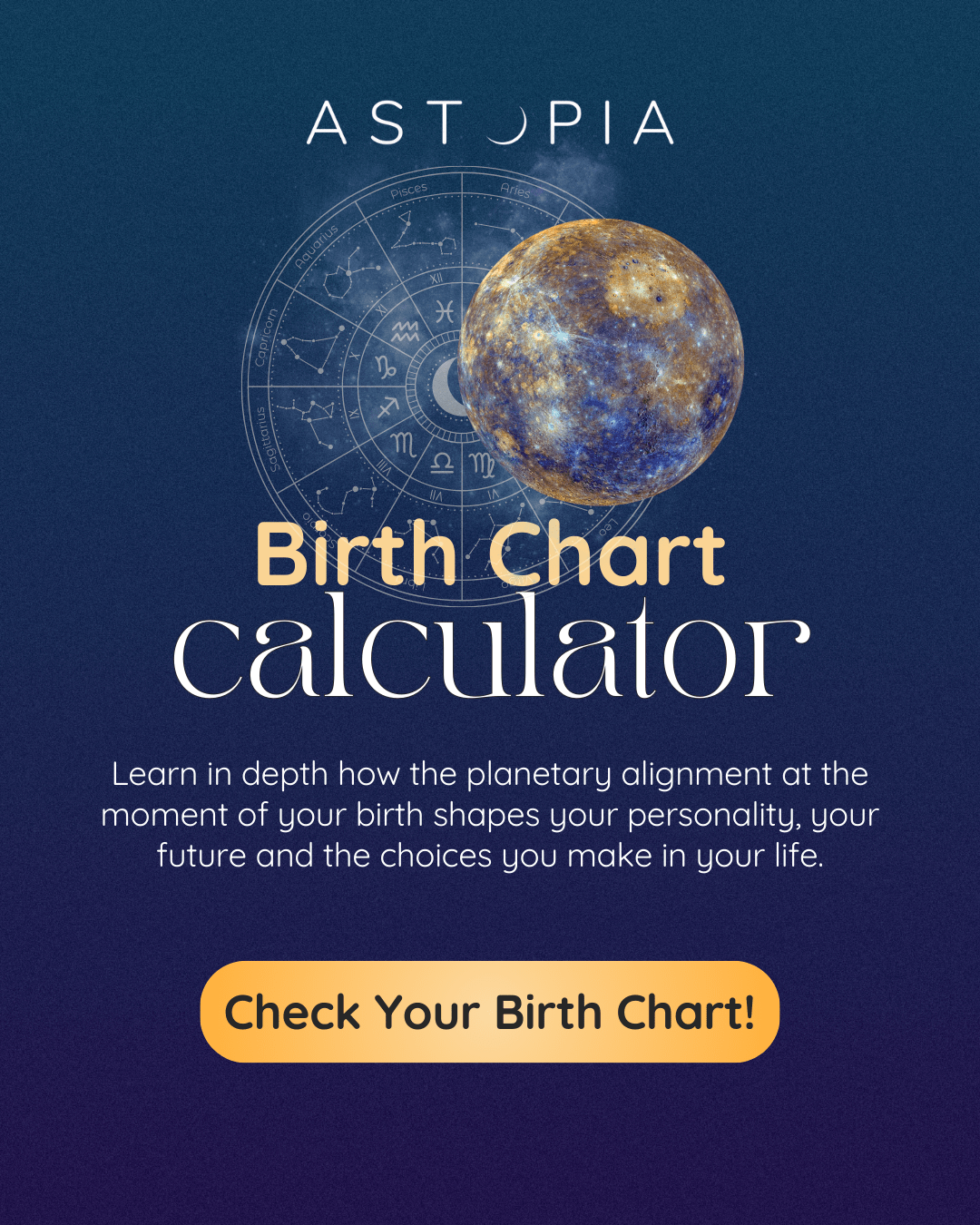
5/23/2024
Author: Astopia TeamShadow Sides in Your Birth Chart: What Do Shadow Traits Reveal?
Shadow self astrology reveals the hidden aspects of the personality, bringing unconscious patterns and repressed emotions into awareness. In the astrology birth chart, shadow sides point to recurring challenges and karmic lessons that shape personal growth. Understanding these hidden traits is essential not only for self-awareness but also for building healthier relationships and achieving balance in life.
In psychological and astrology shadow work, the shadow represents the qualities we deny, suppress, or project onto others. These aspects are often found in the shadow self in birth chart positions, particularly in sensitive areas like the 12th house, also known as the 12th house shadow self. For instance, an individual with planets in this placement may struggle with unconscious fears, karmic debts, or hidden desires. By exploring the astrology shadow chart, one can identify these shadow traits and begin the process of integration. This practice transforms weaknesses into strengths, allowing the individual to align more consciously with their true path. In essence, shadow sides serve as a mirror, reflecting the parts of ourselves that, when acknowledged, become sources of wisdom, healing, and spiritual growth.
What Are Shadow Sides? The Importance of Shadow Traits in Astrology
In shadow self astrology, the term “shadow” refers to the hidden or repressed aspects of the personality that often operate unconsciously. These can include fears, insecurities, or even talents that we do not fully recognize within ourselves. In the astrology birth chart, shadow sides usually reveal hidden traits in birth chart analysis that shape how individuals interact with others and with themselves. These traits are not necessarily negative but become problematic when ignored or denied. For example, someone with a strong emphasis on the 7th house may project their unmet needs onto relationships, while the shadow side of zodiac signs shows how each sign carries its own hidden challenges. Recognizing these tendencies allows individuals to face their weaknesses directly rather than being controlled by them.
The importance of shadow traits lies in their ability to guide personal transformation. When we bring awareness to unconscious patterns in astrology, we begin to understand why certain cycles repeat in our lives. This is why many astrologers emphasize the role of shadow traits astrology in achieving wholeness. For instance, the shadow house natal chart placements often show where fears and self-sabotaging behaviors arise, pointing to karmic lessons that must be addressed. By acknowledging these aspects, individuals can integrate them through shadow integration astrology practices, turning unconscious energies into conscious choices. This not only leads to greater self-awareness but also enhances relationships and spiritual growth, making shadow work a vital tool in psychological and astrological practice alike.
The Connection Between Jung’s Shadow Concept and Astrological Shadow Sides
Carl Jung’s psychological theory of the shadow has become a cornerstone in psychological astrology. Jung described the shadow as the unconscious part of the personality that contains repressed desires, hidden fears, and traits we often reject or deny. In astrology, this concept aligns with shadow self astrology, where the astrology birth chart highlights the areas of life where these hidden traits manifest. Just as Jung argued that integration of the shadow is essential for personal wholeness, astrologers interpret planetary placements, houses, and aspects to reveal the unconscious patterns astrology that keep individuals trapped in cycles of fear, projection, or denial. The astrological shadow therefore mirrors Jung’s psychological shadow, pointing to traits we may avoid but must eventually confront to evolve.
The connection becomes even clearer when exploring shadow archetypes astrology, where planetary influences embody distinct symbolic energies. For instance, Mars in a shadow position may symbolize aggression suppressed into passive-aggressive behavior, while Venus might indicate struggles with self-worth hidden under dependency or avoidance. Recognizing these dynamics is the first step toward shadow integration astrology, a process that involves owning the disowned parts of the self and transforming them into strengths. Just as Jung emphasized the necessity of embracing the shadow for individuation, astrology demonstrates how shadow work in the natal chart can lead to healing, empowerment, and balance. By blending Jungian psychology with astrology, individuals gain a holistic framework to understand and heal the hidden sides of their personality.
What Are Synthesis Signs and Shadow Signs?
In astrology, the concept of the shadow sign opposite the Sun offers valuable insights into personal growth. Every zodiac sign has an opposite, and this polarity forms the basis of opposite sign astrology. The main sign represents qualities we easily express, while the shadow sign shows traits we often deny, resist, or project onto others. For example, someone with the Sun in Aries may find their shadow in Libra, where lessons about balance and cooperation must be learned. In this way, the shadow sign acts as a mirror, reflecting the shadow side of zodiac signs that challenges us to achieve greater self-awareness. Understanding this duality highlights how synthesis between both signs can bring balance, integration, and personal evolution.
Astrologers sometimes describe this dynamic as part of the shadow chart astrology, where hidden or denied aspects of personality are revealed through the interplay of signs and houses. These signs often point to hidden traits astrology, qualities that we unconsciously reject but that form a crucial part of our development. The synthesis sign, therefore, is not just a challenge but a guide toward wholeness, urging us to integrate the shadow rather than suppress it. By working with both the conscious and unconscious expressions of the zodiac, individuals can unlock deeper wisdom, balance their energies, and move closer to authentic self-expression. Recognizing both the light and the shadow ensures that the natal chart becomes a map not only of strengths but also of transformative potential.
Determining the Synthesis and Shadow Sign in the Birth Chart
Identifying the synthesis and shadow sign begins with a careful reading of the astrology birth chart. The Sun sign describes the conscious self, while the shadow sign opposite the Sun shows the unconscious qualities that need integration. This polarity is crucial in understanding the shadow directions natal chart, as it highlights the lessons that arise from balancing both signs. For instance, a Sun in Cancer points to a shadow in Capricorn, where discipline, authority, and responsibility become essential life themes.
To determine synthesis and shadow signs in practice, astrologers focus on several steps:
- Check the Sun sign and its opposite sign → This reveals the primary shadow dynamic.
- Analyze planetary oppositions → Opposite placements often indicate where shadow energies surface.
- Look at the Moon and Ascendant sign → These positions influence hidden emotional needs and projection patterns.
- Study the 12th house and 7th house → The shadow house natal chart often points to repressed or projected traits.
- Review aspects to Chiron → These show karmic wounds and hidden traits in birth chart interpretation.
By following these steps, astrologers map the synthesis between the conscious and unconscious self. This process highlights not only challenges but also growth opportunities, helping individuals integrate their shadow and achieve balance.
Discovering Shadow Sides in the Birth Chart
Uncovering shadow sides in astrology requires a deep reading of the natal chart, where the shadow self in birth chart placements reveal hidden fears, repressed desires, or unresolved karmic lessons. These shadow patterns often remain invisible until they manifest as repetitive challenges in life. By analyzing the shadow chart astrology, astrologers identify not only the conscious strengths but also the hidden traits in birth chart interpretation that shape a person’s destiny. This process is crucial in subconscious astrology, as it shows the influence of unconscious forces on daily life and relationships.
To discover shadow sides in your chart, astrologers typically focus on the following areas:
- 12th House placements → Symbolize the deepest unconscious fears and karmic residues (12th house shadow self).
- 7th House placements → Show projection of qualities onto others, often mirrored in relationships.
- Planetary oppositions → Represent polarity between conscious and unconscious traits.
- Aspects to Chiron → Highlight wounds and potential healing paths tied to unconscious patterns astrology.
- Moon and Ascendant sign → Reveal emotional triggers and instinctive shadow behaviors.
By identifying these elements, individuals can begin the process of integrating shadow energies. This journey transforms limitations into wisdom, making the natal chart not only a map of strengths but also a guide for healing and personal evolution.
Shadow Sides of Planets and Houses
In astrology, every planet and house carries not only its strengths but also its shadow side. These shadows often reveal unconscious patterns astrology, behaviors that we are unaware of but that influence our choices, relationships, and emotional responses. When we explore the shadow house natal chart, we can uncover where these challenges appear most intensely. For example, the 12th house may indicate suppressed fears, while the 7th house can show projections onto relationships. Similarly, planets also carry shadow expressions; the Sun may become egocentric, Mars may turn aggressive, and Venus may manifest as dependency when not balanced. Recognizing these patterns in the astrology houses allows us to bring hidden traits in the birth chart into conscious awareness.
The table below summarizes common shadow tendencies of planets and houses. It provides an accessible framework for anyone exploring shadow traits astrology and working toward integration:
| Planet/House | Shadow Expression | Healing Potential |
| Sun | Ego, pride, need for control | Authentic self-expression, balanced leadership |
| Moon | Moodiness, emotional insecurity | Emotional awareness, nurturing compassion |
| Mercury | Manipulation, dishonesty | Clear communication, truthful expression |
| Venus | Dependency, vanity | Healthy relationships, self-love |
| Mars | Aggression, impulsivity | Courage, constructive action |
| Jupiter | Excess, overconfidence | Wisdom, moderation, expansion with purpose |
| Saturn | Fear, rigidity, guilt | Discipline, responsibility, karmic growth |
| 7th House | Projection onto partners | Building balanced, conscious relationships |
| 12th House | Repression, hidden fears | Spiritual healing, subconscious integration |
This approach shows that shadow sides are not punishments but opportunities. By working with planetary and house shadows, individuals can achieve greater balance and begin the path of integration.
Shadow Sides According to Zodiac Signs
Each zodiac sign has both strengths and weaknesses, and in shadow self astrology, these weaknesses are understood as the shadow side of zodiac signs. They represent the hidden fears, insecurities, and repressed behaviors that can emerge when energy is unbalanced. For example, Aries may struggle with impatience and aggression, while Libra may fall into indecisiveness or dependency. These qualities are often described as the dark side of zodiac signs, but in reality, they point to areas of growth and healing. By recognizing these shadow traits astrology, individuals can learn to transform destructive habits into constructive actions. The goal is not to eliminate shadow energies but to integrate them, making them part of a fuller, more authentic self.
Astrologers often emphasize that the shadow energies in zodiac are essential for personal evolution. Without acknowledging the shadow, one risks repeating the same unconscious cycles. For instance, Scorpio’s shadow may involve obsession or control, while Pisces may struggle with escapism or lack of boundaries. Understanding these traits in the zodiac signs chart allows individuals to confront their hidden patterns and consciously redirect their energy. In this way, shadow work becomes a key step toward wholeness, offering both self-awareness and transformation. The journey through the shadow side of zodiac signs is therefore a path of empowerment, showing that even the darkest aspects of personality can be turned into wisdom and strength.
Aries Shadow Traits
Aries in the shadow side of zodiac signs can show impatience, impulsivity, and aggression. When unbalanced, they may dominate others, but awareness transforms this into courage and healthy leadership.
Taurus Shadow Traits
Taurus shadows often manifest as stubbornness, possessiveness, or over-attachment to material security. In shadow traits astrology, these qualities teach lessons about flexibility and inner value.
Gemini Shadow Traits
Gemini’s dark side of zodiac signs may involve gossip, superficiality, or inconsistency. However, these shadow patterns can evolve into adaptability and clear communication when integrated.
Cancer Shadow Traits
Cancer shadows appear as emotional manipulation, dependency, or fear of abandonment. Facing these hidden traits astrology leads to nurturing compassion and emotional balance.
Leo Shadow Traits
Leo’s shadow often includes arrogance, vanity, or craving excessive attention. Recognizing this side allows Leo to channel energy into inspiring others rather than seeking validation.
Virgo Shadow Traits
Virgo’s shadow traits astrology center on criticism, perfectionism, and anxiety. These traits, once acknowledged, become tools for service, healing, and constructive organization.
Libra Shadow Traits
Libra shadows may show as indecision, people-pleasing, or avoidance of conflict. Working through these energies leads to true harmony, fairness, and authentic partnerships.
Scorpio Shadow Traits
Scorpio’s dark side of zodiac signs includes obsession, jealousy, and control issues. When integrated, these intense energies bring transformation, resilience, and deep wisdom.
Sagittarius Shadow Traits
Sagittarius in shadow may express as dogmatism, restlessness, or irresponsibility. In shadow side astrology, these traits point to the need for grounded belief systems and purposeful exploration.
Capricorn Shadow Traits
Capricorn shadows include workaholism, rigidity, and excessive ambition. Awareness turns these patterns into discipline, responsibility, and balanced authority.
Aquarius Shadow Traits
Aquarius may struggle with detachment, unpredictability, or rebelliousness in its shadow form. These traits evolve into innovation, social awareness, and true collective healing.
Pisces Shadow Traits
Pisces shadows manifest as escapism, lack of boundaries, or victim mentality. Recognizing these hidden traits astrology helps cultivate empathy, spiritual depth, and compassion.
Astrological Analysis and Shadow Sides
In astrology, analyzing shadow sides requires looking beyond surface traits and diving into the hidden layers of the astrology shadow chart. This chart highlights the unconscious forces that shape behaviors, fears, and karmic lessons. While the natal chart shows conscious strengths and personality traits, the shadow chart reveals the parts of ourselves we resist or deny. These may include unresolved wounds, fears of failure, or repressed desires that often appear through recurring life patterns. By combining insights from shadow self astrology with planetary aspects, houses, and oppositions, astrologers uncover the deeper psychological and spiritual dimensions of personality.
The goal of this analysis is not to eliminate the shadow but to integrate it through shadow integration astrology. When individuals recognize their unconscious patterns astrology, they gain the ability to transform destructive cycles into conscious choices. For example, a person with strong 12th house placements may struggle with hidden fears or self-sabotage, but awareness of these energies turns them into tools for healing. In karmic astrology, shadow sides also point to unresolved lessons carried from past lives, offering guidance for the soul’s growth. Astrological analysis therefore becomes a roadmap for transformation, helping individuals face their hidden traits, embrace their full identity, and achieve balance between light and shadow.
Frequently Asked Questions
What is a shadow sign?
A shadow sign in astrology refers to the zodiac sign that represents the hidden or repressed aspects of your personality. It is usually found by looking at the shadow sign opposite the Sun, showing the traits you may deny in yourself but notice in others. For example, if your Sun is in Leo, your shadow sign is Aquarius, representing qualities of detachment or unpredictability that you may struggle with. In shadow self astrology, this concept is essential for understanding the darker or less visible parts of who you are.
The shadow sign is not negative in itself—it serves as a mirror. It highlights lessons that must be learned for personal growth and balance. Working with the shadow sign is part of shadow integration astrology, where you embrace these hidden qualities rather than reject them. By doing so, you align your conscious and unconscious selves, gaining a more complete sense of identity and wholeness.
How do you calculate your shadow sign?
To find your shadow sign, you need to identify the zodiac sign opposite your Sun in the astrology shadow chart. This is based on the natural polarity system of the zodiac: Aries opposes Libra, Taurus opposes Scorpio, Gemini opposes Sagittarius, Cancer opposes Capricorn, Leo opposes Aquarius, and Virgo opposes Pisces. For instance, someone born with the Sun in Taurus would have a shadow sign in Scorpio, revealing lessons around control, intimacy, and transformation.
Astrologers also use additional placements, such as the Moon sign, Ascendant sign, and 12th house, to refine the calculation. These placements reveal hidden traits in birth chart analysis that deepen your understanding of shadow dynamics. By combining Sun polarity with other chart factors, the shadow sign can be determined more accurately, offering a fuller picture of your unconscious patterns and karmic lessons.
Why is it important to know the shadow traits of zodiac signs?
Understanding the shadow side of zodiac signs is crucial because it reveals the hidden struggles that influence personality and relationships. Each sign carries both strengths and weaknesses, and by acknowledging the shadow, we avoid repeating unconscious cycles. For example, Aries may struggle with impulsivity, while Virgo may fall into perfectionism. These shadow qualities, if left unchecked, often appear in repetitive patterns of behavior. In shadow traits astrology, the aim is to bring awareness to these tendencies so that they can be transformed into strengths rather than obstacles.
The importance of knowing shadow traits lies in self-awareness and growth. When individuals study the hidden traits in birth chart analysis, they begin to understand why certain challenges keep resurfacing. This awareness allows them to take conscious action instead of reacting automatically. By integrating the shadow, one not only achieves personal balance but also improves relationships, career, and spiritual growth. In short, recognizing the shadow self astrology side of each sign provides a powerful tool for self-improvement and empowerment.
How do you work with shadow sides?
Working with shadow sides involves a process of awareness, acceptance, and transformation. In astrology, this is known as shadow integration astrology or shadow work. The first step is identifying the shadow through the astrology shadow chart, focusing on placements such as the 7th house, 12th house, and oppositions. Once identified, the goal is not to eliminate the shadow but to integrate it. For example, someone with a strong Scorpio shadow may learn to transform obsession and control into resilience and deep emotional understanding.
Practical methods of working with the shadow include journaling, therapy, meditation, and conscious relationship dynamics. In astrology, this process also involves reflecting on shadow work practices connected to Chiron, Saturn, and lunar nodes, which often highlight karmic lessons. By acknowledging fears, insecurities, and unconscious patterns astrology, individuals transform them into wisdom and strength. This approach creates a balanced self where both light and shadow coexist in harmony, allowing true authenticity to shine.





